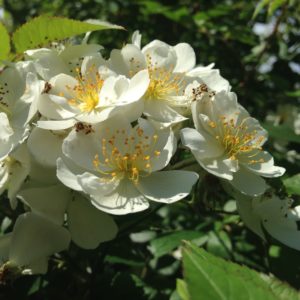Preparing Roses for Winter in November
Views: 805

Frost on the pumpkin
Frost on the pumpkin in the early morning hours is a sure sign that colder weather is here. Hard frosts will soon follow. Old Man Winter is sure to be next.
Every year it seems as though these first hard frosts come earlier and earlier. We have already had a few hard frosts here in Southern New England, but by mid-day temperatures are back in the 50’s. This won’t last too much longer before Old Man Winter takes control.
November is the time when Mother Nature’s creatures finish preparing for their long winter naps, but it is also a time when cold-weather rosarians get their roses ready for winter.
My winter preparations start long before November
Winter preparations in my garden start long before November. I start as early as when I’m researching which varieties to grow. One of the most important characteristics I look for when researching roses to plant in my zone 5b/6a garden is winter hardiness. As a gardener, you should know which zone you live in. It is important to use this information when you decide which plants to purchase and grow in your garden.
Winter preparations continue at planting time
Successful winter preparations continue when you plant your roses. Planting the graft on grafted roses below grade as I discussed in my April, 2020 blog is part of having your roses survive the low winter temperatures and harsh winter winds. Roses that have their grafts planted at or above ground level run the risk of having the graft freeze and the rose dying in the process. When this happens, the rose reverts to the rootstock and must be replaced.
The correct plant hardiness zone for your roses
Roses grow best when they are grown in the correct climate/zone. The winter hardiness of roses varies depending on the genetics within. You can grow roses successfully that are a zone or two warmer than your zone by protecting these roses from the low temperatures and harsh winter winds. However, there are limits how far beyond your zone that you can go.
Late fall preparations
Late fall winter preparations for your roses often depend of the type of rose that you are growing. There is no “one size fits all” when it comes to winter preparation. There are four major types of roses, and winter preparations are different for each type.
Four major types of roses
The four major types of roses are hardy once-blooming roses, non-hardy once-blooming roses, hardy repeat-blooming roses, and non-hardy repeat-blooming roses. By far, roses that are hardy are much easier to prepare for winter than non-hardy varieties. Please also note that any varieties I may list may be hardy here in Southern New England, may/may not be hardy in your area. Consult with your local consulting rosarians from more information on which roses are hardy in your area.
Hardy Once-Blooming Roses
Roses that are hardy and once-blooming in my garden are only shaped as desired and that’s pretty much it when it comes to winter preparation. I do not trim any canes other than those that are either dead or diseased. I tie up any new canes on their supports that have grown during the growing season. Once-blooming Ramblers, Shrubs, and Old Garden Roses are prepared this way. They are pruned back in June/July right after they finish blooming. See my July, 2020 blog on how this is done.
Please note that any canes you may cut out now will result in fewer blooms next year. I usually do not do any additional winter protections on my hardy once-blooming roses. Mother Nature has set forth genes that are able to withstand her forces for surviving the harsh winter months, and I’m going to exploit them and use them to my benefit. When spring rolls around in a few months, most of my once-blooming hardy roses have little-to-no dieback and are ready to go with minimal spring pruning.
Some hardy once-blooming varieties I grow
Some of the hardy once-blooming roses that I grow/have grown include Dr. W. Van Fleet, Variegata di Bologna, Gallica Macrantha, Purple East, R. canina, R. wichurana, R. multiflora, R. rubrifolia, Dr. Huey, White Dawn, Cinderella, Dorothy Perkins, Mme. Plantier, as well as some of my seedlings. Please note that these roses that are listed grow and spread by sending out long canes from a central point. They tend to be big and fill large areas of the garden.
Hardy once-blooming running roses
Other once-blooming hardy roses grow a little differently. They are generally much shorter and spread by sending out runners underground. These roses have a tendency to spread far and wide throughout the garden through these runners, and it is not uncommon to find these runners 10’ (or more) from where they were originally planted. As these runners pop up and grow, they do not bloom the first year, but bloom the following year after a period of winter dormancy.
Once-blooming hardy roses that spread by runners include many Centifolias, Gallicas, and Moss roses. While I generally like my roses to stay put where I plant them, roses that spread through runners and are low-growing have their use in “wild” gardens.
Some hardy once-blooming running roses I grow
Some of the once-blooming spreading roses that I grow/have grown include R. carolina, R. virginiana, R. gallica officinalis, R. arkansana, R. gallica versicolor, Charles de Mills, Alain Blanchard, Common Moss, La Belle Sultane, Tuscany, Tuscany Superb, Alika, Pom Pom de Bourgone, as well as many found roses.
I do not add any winter protections to these roses, and only remove dead and diseased canes when I prepare them for winter. These roses don’t bat an eye and are ready to go again in the spring with little-to-no dieback.
Non-hardy once-blooming roses
Non-hardy once-blooming roses are a bit more of a challenge. The winter temperatures and harsh winds will damage the canes and in the process either outright kill the rose or severely limit the number of blooms you have during the next growing season unless protective measures are taken. Protecting these roses includes wrapping burlap around the canes, removing the canes from their supports and burying these canes, as well as growing these roses in containers and protecting them in greenhouses and non-heated garages over the winter.
I do not currently grow any once-blooming roses that are not hardy. I do not have the time to do what is required during the fall/winter most years and leave the job of growing them to our Southern and Western rosarians in milder climates.
World’s largest rose – Lady Banks Rose
One very famous example of a non-hardy once-blooming rose is a specimen of the Lady Banks Rose (R. banksiae) growing in Tombstone Arizona. It is considered to be the world’s largest rose, and covers some 8,000 square feet and has been growing there for some 135+ years. Every April the plant has hundreds of thousands of blooms. While the Lady Banks Rose thrives in many southern and western gardens, it is not hardy here in New England. If it was, I would grow it here to enjoy its beauty in my garden.
Hardy repeat-blooming roses
Hardy repeat-blooming roses are the most common type of rose that I grow. I do not add any additional winter protections to these roses other than planting them deep and let the genetics within the roses do the work for me. Canes are pruned to 4’-5’ high, so that they do not sway and dry out in the winter winds. Dead and/or diseased canes are removed.
I will, however, never assume that any new rose that I buy/grow that is supposed to be winter hardy in my area is actually hardy. I let these roses prove to me that they are hardy and don’t need any extra protection(s). For the first year or two that I grow these roses, I protect these roses as if they aren’t hardy to give them a chance to prove to me that they actually are.
Some hardy repeat-blooming rose I grow
Hardy repeat-blooming roses can be found in many different classes or roses. They are most commonly found in the shrub classes. Some of the hardy repeat-blooming roses that I grow/have grown include many of my seedlings, Ballerina, Cupid’s Kisses, Bonica, George Oliva, Hera’s Song, Knock Out, Home Run, Cape Diamond, Party Hardy, Dortmund, New Dawn, Awakening, John Cabot, R. rugosa, R. rugosa alba, Gourmet Popcorn, Pink Brickhouse, Abigail Adams Rose, Darlow’s Enigma, Perennial Blue, Therese Bugnet, Campfire, Teasing Georgia, Joasine Hanet, Carefree Beauty, President Shanley, and many more!
Non-hardy repeat-blooming roses
Non-Hardy repeat-blooming roses can be grown successfully in the colder regions if additional winter protection(s) are used. Many rosarians grow these roses very successfully by adding these protections. Protecting against the elements starts when the roses are planted. The graft is planted below ground level as described in my April, 2020 blog. It is the first line of defense against what Mother Nature sets forth during winter. However, just planting roses deeply with the graft below ground level may not be enough to keep them from winter damage. In addition to planting the graft below ground level, additional winter protection is gleaned by mounding up the roses 10”-12” (full-sized roses – miniature and miniflora roses 8”-10” high) with mulch/soil/leaves and/or compost from another area of the garden.
A quick note:
Note: you should never take the soil/mulch from the same area of the garden as the rose that you are protecting. Taking soil from the same area could expose the roots to the elements and damage the plants. It is also best to add these additional protections after the first hard frost(s). Adding the protection after these frosts, helps to insure that Mother Nature’s furry creatures have already found refuge elsewhere. They don’t have a need to use the newly-created mounds as homes. The damage that these furry creatures can wreak can be catastrophic. I have seen many roses severely damaged and some even killed outright, when rodents have free reign on buried roses all winter long. More often than not, the damage caused is not discovered until spring. By then it is too late to save these roses.
Other winter preparation methods
While these are my methods for protecting hardy and non-hardy roses during winter, other rosarians use alternate ways to protect their hardy and non-hardy roses. These methods include, but are not limited to:
Rose collars
- Rose Collars – Rose collars are specifically designed to protect roses during winter. The rose bush is trimmed down so that the collar fits over it without forcing the canes inside. The collar is left in place until spring. Many rosarians often take the covers off of these collars during the warmer days so that the rose does not break dormancy and start to grow. They put the covers back on before nighttime freezing temperatures return.
- Making Your Own Rose Collars – An alternative to using collars specifically made to protect roses during winter, is to make your own collars out of chicken wire. A 10”-12” high and wide chicken wire cylinder is made and secured upon itself. The cylinder is centered around the rose to be protected and filled up with leaves, straw, and mulch. Since these collars have an open top, they are just be left alone until spring.
Containerized roses
- Placing Containerized Roses in Unheated Garages – Roses that are grown in containers can be put in unheated garages until spring. Keeping the roses hydrated is one of the keys to successfully overwintering roses in unheated garages.
- Burying Containerized Roses – Containerized roses can also be buried until spring. It is a lot of work burying the containers. Protecting the roses against rodents overwintering with the buried roses can be a challenge.
- Placing Containerized Roses in Greenhouses and Cold Frames – For those who have greenhouses and cold frames, overwintering your containerized roses in greenhouses and cold frames is a time-tested way of getting them through the winter. Aphids and other pests can be a problem in greenhouses and cold frames. Natural predators are not available to keep them at bay.
Construction blankets
- Construction Blankets – The rose garden within the Montreal Botanical Garden has a technique where they cover their roses with construction blankets. The blankets protect the roses during the low winter temperatures and high winds. They are left in place until spring.
Objective of winterizing roses
Well folks, that’s it for now on winterizing and getting your roses ready for their winter naps. One thing that should be stressed is that the object of using protection on roses is to keep the roses cold and dormant and free from fluctuating temperatures. It is not to keep them warm. Any protection(s) that you add must be kept in place until spring when the danger of nighttime frost(s) has subsided. Once you are able to master these processes, you are well on your way to creating your dream rose garden to enjoy for many years to come.
Epilogue
This story was written with my trustee blue Osmiroid fountain pen. I have used this pen many times before. However, I wanted to get back to some variety in the color(s) I write with. I have also been having trouble getting anything (except black) at the local art supply stores. It is the first time that I have ventured into the huge arena of procuring ink colors beyond basic black/blue online.
Within the greater fountain pen community, color choices are vast, and prices can sometimes be frightfully expensive. I wanted to also support a small business and not order from some huge corporation. Some Pelikan inks in different shades of blue/green/brown were ordered from a small supplier in the fountain pen community. I have been very happy with my purchase. Making corrections with a contrasting ink color with my Moore marbled pen certainly makes the editing process so much easier.
Happy belated Thanksgiving to everyone! My next blog will be in a couple of weeks. I will have more rosy thoughts in December about what’s going on in the world or roses. Until then . . .
Meet Andy Vanable
Andy's Recent Posts

The Rose-Growing World Loses an Icon – Bob Martin






